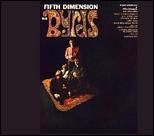Marketing
The Byrds - Fifth Dimension (1966)

In July, the album Fifth Dimension finally appeared. Except for Gene Clark's swan song, "Eight Miles High," on which all five original Byrds appeared, the album featured the second incarnation of the band, McGuinn, Crosby, Hillman and Clarke, with Hillman assuming the responsibility for a third vocal part. Like the single, the album was a deliberate departure from the sound and substance of the first two LPs. No Dylan or Seeger songs were in evidence, though four of the songs had roots in folk music. With Clark gone, the band eschewed straightforward pop songs, opting instead for more experimental fare. McGuinn and Crosby each began to come into their own as songwriters with this album, and collaborated well together on several numbers. Elsewhere, though, were signs of the rift that would develop between the two.The new, post-Clark equilibrium is displayed to good effect on the two folk standards, the traditional "Wild Mountain Thyme," and "John Riley," a song by Bob Gibson and previously recorded by Odetta. Both feature strong harmonies, and for the first time, string arrangements. These are Allan Stanton's contribution, and are used sparingly enough that they don't overwhelm the material.Crosby and McGuinn collaborate on "I See You," which they co-wrote. The modal melody and free verse lyrics sound like the work of Crosby, and McGuinn's tenor vocal sounds as if he's deliberately imitating Crosby. McGuinn's contribution is another round of the angular, Coltranesque guitar style used on "Eight Miles High."Surprisingly, the most effective collaboration between McGuinn and Crosby appears on "What's Happening?!?!," Crosby's first solo songwriting credit with the band. The song is a successful experiment with subject matter and song structure in which McGuinn responds to each verse with a different sitar-like guitar lick. The raga influence is even stronger on this number than on "Why," and McGuinn's solos effectively complement Crosby's lyrical theme of confusion and disorientation.The other Crosby song is "Hey Joe (Where You Gonna Go)," which he had picked up from longtime chum Dino Valenti. The Byrds had been performing the song live for some time, and the song came to be associated with Crosby. He had been wanting to record the song for some time, and became frustrated when rival LA bands scored with it. At his insistence, the band recorded their own version. The most notable apsect of the song is not Crosby's punky singing -- it's the strong bass work by Hillman and McGuinn's guitar work, again in his skittery new style.One of McGuinn's contributions also had its roots in the folk movement. For "I Come and Stand at Every Door," McGuinn set the words to a poem by Nazim Hikmet to a traditional ballad called "Great Selchie of Shule Skerry," which Judy Collins had recorded on The Golden Apples of the Sun (Elektra, 1963). With its morbid lyrics about the ghost of a child killed in Hiroshima, this song might have become little more than a gruesome dirge, but the elegiac melody and simple arrangement just barely manage to keep the song in the realm of good taste.McGuinn's two solo compositions are the standouts, which must be why they were chosen as the two singles. "5D (Fifth Dimension)" is sort of an attempt to explain Einstein's theory of relativity, based on a book that had caught McGuinn's fancy called 1-2-3-4, More, More, More, More by one Don Landis. To McGuinn's dismay, its trippy lyrics were, not surprisingly, interpreted as an ode to the lysergic experience. Whatever it meant, it sure sounds good. Check out the harmonies on the chorus, and the rousing "Ooooooooohhhhh!!!" that launches the next verse. Professional eccentric Van Dyke Parks adds some nice keyboards.The whimsical "Mr. Spaceman" continues the band's tentative exploration of country music, which they are still unwilling to attempt without a veneer of ironic detachment to protect their hipness. Nevertheless, it's an engaging song, with the best melody by McGuinn up to that point. (The song is no relation to the 1964 Holy Modal Rounders track by the same name.)The final McGuinn composition (you couldn't really call it a song) is a throwaway called "2-4-2 Fox Trot (The Lear Jet Song)." As indicated by its subtitle, it was a nod to John Lear, who had befriended the aviation-besotted McGuinn around this time. The track's jet engine sound effects and control tower exchanges seem mundane today, though they were something of an innovation at the time (compare "Yellow Submarine" by the Beatles a few months later).Somewhat out of place, not just on this LP, but in the entire Byrds repertoire, is the slight soul/blues instrumental vamp, "Captain Soul." All four band members receive writing credits, but Michael Clarke is the one who thought the band should try an R&B song. "Captain Soul" is based on the opening riff of the song "Get Out of My Life Woman," a hit for the great New Orleans soul singer Lee Dorsey in early 1966, written by New Orleans musical giant Allan Toussaint.Fifth Dimension had many strong cuts, particularly the three singles, but is a bit more uneven than its two predecessors. It would prove to be a transitional album, a glimpse of the second version of the band trying to establish a balance among its members' songs, interests and egos.
Tracks
1. 5D (Fifth Dimension)
2. Wild Mountain Thyme
3. Mr. Spaceman
4. I See You
5. What's Happening?!?!
6. I Come And Stand At Every Door
7. Eight Miles High
8. Hey Joe (Where You Gonna Go)
9. Captain Soul
10. John Riley
11. 2-4-2 Fox Trot (The Lear Jet Song)
Bonus Tracks
12. Why (Single Version)
13. I Know My Rider (I Know You Rider)
14. Psychodrama City
15. Eight Miles High (Alternate/RCA Studios Version)
16. Why (Alternate/RCA Studios Version)
17. John Riley (Instumental Version 1)
Link
Post je objavljen 10.09.2008. u 21:29 sati.